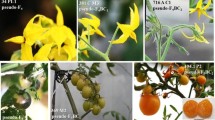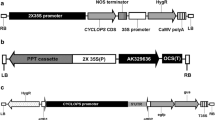Summary
A method is described for selecting resistant transformed tomato genotypes in vitro at the stage of immature embryos. The utilization of HLH nutrient medium with the selective agent kanamycin is proposed. Normal development of seedlings from immature embryos, which do not form callus, is a good and true indicator for isolation of resistant genotypes. The immature embryos do not germinate and develop on MS selective medium.
Similar content being viewed by others
References
Basiran, N., P. Armitage, R.J. Scott & J. Draper, 1987. Genetic transformation of flax (Linum usitatissimum) by Agrobacterium tumefaciens: regeneration of transformed shoots via a callus phase. Plant Cell Repts. 6: 396–399.
Bevan, M., 1984. Binary Agrobacterium vectors for plant transformation. Nucleic Acids Research 12: 8711–8721.
Brunold, C., S. Kruger-Lebus, M.W. Saul, S. Wegmuller & I. Potrykus, 1987. Combination of kanamycin resistance and nitrate reductase deficiency as selectable markers in one nuclear genome provides a universal somatic hybridizer in plants. Mol. Gen. Genet. 208: 469–473.
Chesnokov, Yu.V., 1992. The transfer of alient genes into embryo sac of higher plants via pollen germination. Biopolymery i Kletka 8: 52–58 (in Russian).
Chesnokov, Yu.V., G.I. Sedov & N.A. Vikonskaya, 1989. Simple method of the genetic transformation of dicot plants. Izvestiya AN MSSR. Ser. biol. i chim. nauk 6: 61–62 (in Russian).
Chesnokov Yu.V., V.K. Burilkov, N.A. Vikonskaya & A.B. Korol, 1991. The Method of the Genetic Transformation of Plant. Patent of the USSR. SU Nr. 1708849 A1.
Chesnokov, Yu.V. & A.B. Korol, 1993. Transfer of alien genes into intact maize plants by means of a pollination-fecundation process. Genetika 29: 1345–1355 (in Russian).
Deblaere, R., A. Reynaerts, H. Hofte, J.-P. Hernalsteens, J. Leemans & M. Van Montagu, 1987. Vectors for cloning in plant cells. In: R. Wu (Ed.), Methods in Enzymology. Recombinant DNA. Part D, 153: 277–292.
Feldmann, K.A. & M.D. Marks, 1987. Agrobacterium-mediated transformation of germinating seeds of Arabidopsis thaliana: a non-tissue culture approach. Mol. Gen. Genet. 208: 1–9.
Luo, Z.X. & R.A. Wu, 1989. A simple method for the transformation of rice via pollen-tube pathway. Plant Mol. Biol. Repts. 7: 67–77.
Maniatis, T., E.E. Fritsch & J. Sambrook, 1982. Molecular cloning. A laboratory manual. Cold Spring Harbor Laboratory.
Murashige, T. & P.A. Skoog, 1962. A revised medium for rapid growth and bioassays with tobacco tissue culture. Physiol. Plantarum 15: 473–493.
Neal, C.A. & L.D. Topoleski, 1983. Effects of the basal medium on growth of immature tomato embryos in vitro. J. Amer. Soc. Hort. Sci. 108: 434–438.
Philippova, G.I., N.A. Omelianchuc, M.I. Rivkin, V.V. Gulevich & A.V. Vershinin, 1991. Wheat transformation by pollen tubes methods. In: K.G. Skryabin (Ed.), Plant Biotechnology and Molecular Biology. Puschino, p. 138. H. Uchimiya, T. Handa & D.S. Brar, 1989. Transgenic plants. J. Biotechnology 12: 1–20.
Author information
Authors and Affiliations
Rights and permissions
About this article
Cite this article
Chesnokov, Y.V., Sedov, G.I. In vitro selection of tomato transformants at the immature embryo stage. Euphytica 81, 79–83 (1995). https://doi.org/10.1007/BF00022461
Received:
Accepted:
Issue Date:
DOI: https://doi.org/10.1007/BF00022461




